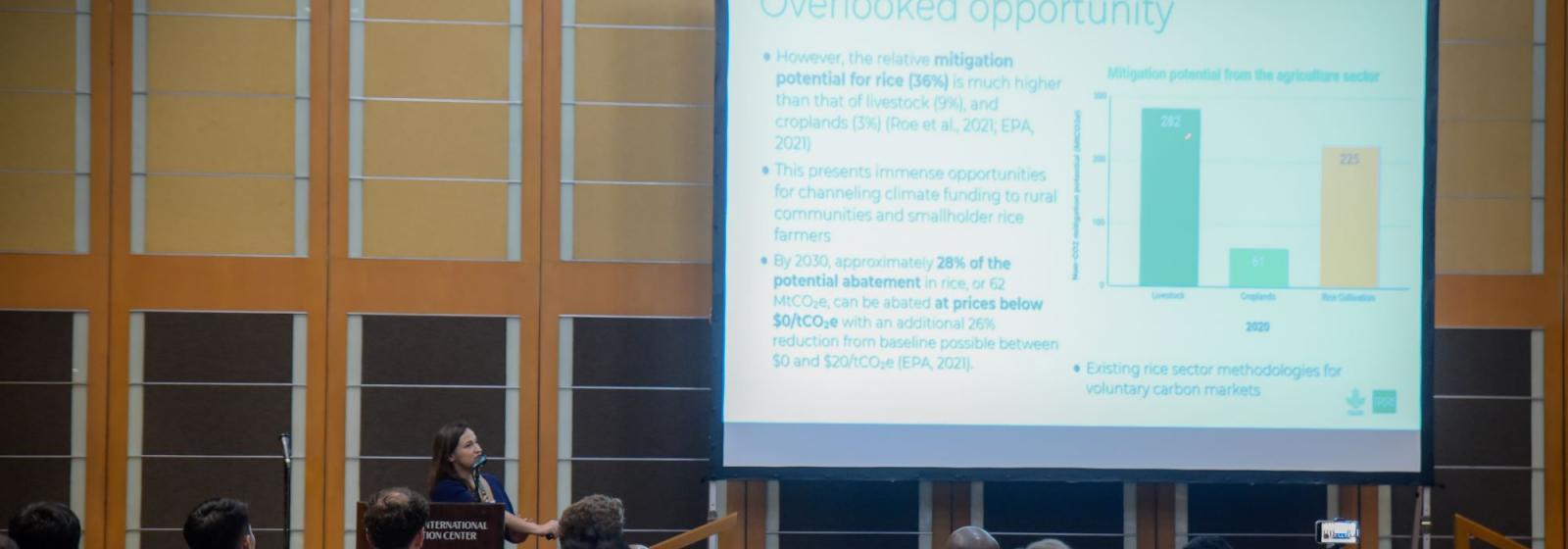Technologies and methodologies for low-emission rice cultivation can open doors to climate financing for smallholder farmers
- From
-
Published on
28.11.23
- Impact Area

MANILA, Philippines (17 October 2023) — Farmers who practice low-emission rice cultivation could soon be able to augment their incomes by selling carbon credits on the global carbon market. This was the potential scenario presented by climate scientists during the discussion on rice farming and carbon markets at the 6th International Rice Congress.
A 2022 Intergovernmental Panel on Climate Change (IPCC) report called for various sectors to reduce greenhouse gas (GHG) emissions by half by 2030. This includes rice farming, which is a significant contributor to anthropogenic emissions. But how do you incentivize rice farmers to take up sustainable rice farming methods without any apparent benefit to gain?
Climate scientists from the International Rice Research Institute (IRRI), Gold Standard Foundation, CarbonFarm Technology, and Rikolto discussed opportunities for bringing climate investment and funding to rural communities and smallholder rice farmers.
“Globally, rice cultivation is the third-largest source of non-CO2 GHG emissions in agriculture, next to livestock and all croplands,” said Katherine Nelson, a climate scientist from IRRI. “However, the relative mitigation potential for rice, at 36%, is much higher than that of livestock and all croplands, which are at 9% and 3%, respectively (Roe et al., 2021; EPA, 2021). This presents immense opportunities for channelling climate investment and funding to rural communities and smallholder rice farmers,” Dr. Nelson added. “With already existing low-emission technologies, over 50% reduction can be achieved (IPCC, 2019).”
However, converting offset emissions into carbon credits requires a standardized way to quantify and certify emissions.
Building on the efforts of the Business Partnerships Platform (BPP), a program that collaborates with businesses to address development challenges to scale carbon market access for smallholder farmers in Vietnam, Gold Standard launched a universal…
Related news
-

Mapping for Resilience: How Spatial Data is Transforming Karamoja Cluster
Ibukun Taiwo02.07.25-
Climate adaptation & mitigation
Pastoral communities in the Karamoja Cluster (a region spanning Kenya, Uganda, South Sudan, and Ethi…
Read more -
-

Building Resilience and Regeneration: The Central Highlands Ecoregion Foodscape (CHEF)
Sehlule Muzata02.07.25-
Climate adaptation & mitigation
At the CGIAR Sustainable Farming Program (SFP), we believe that collaboration is essential for trans…
Read more -
-

Planting with Precision: How Weather and Climate Information is Changing Bean Farming in Rwanda
The Alliance of Bioversity International and the International Center for Tropical Agriculture (CIAT)01.07.25-
Climate adaptation & mitigation
Imagine weather information as a GPS for farmers. Without it, the journey becomes uncertain, filled…
Read more -
